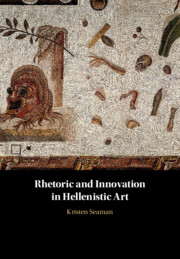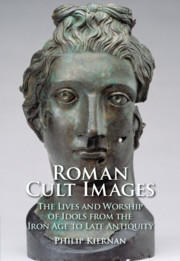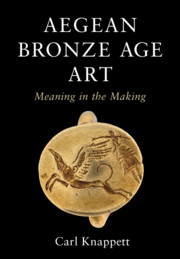Refine search
Actions for selected content:
5894 results in Classical art and architecture
Three - The Birth of Cult Images
-
- Book:
- Roman Cult Images
- Published online:
- 15 May 2020
- Print publication:
- 11 June 2020, pp 85-145
-
- Chapter
- Export citation

Rhetoric and Innovation in Hellenistic Art
-
- Published online:
- 16 May 2020
- Print publication:
- 16 April 2020

Roman Cult Images
- The Lives and Worship of Idols from the Iron Age to Late Antiquity
-
- Published online:
- 15 May 2020
- Print publication:
- 11 June 2020

Aegean Bronze Age Art
- Meaning in the Making
-
- Published online:
- 18 April 2020
- Print publication:
- 25 June 2020
Chapter Five - Conclusion
-
- Book:
- Rhetoric and Innovation in Hellenistic Art
- Published online:
- 16 May 2020
- Print publication:
- 16 April 2020, pp 132-134
-
- Chapter
- Export citation
Bibliography
-
- Book:
- Rhetoric and Innovation in Hellenistic Art
- Published online:
- 16 May 2020
- Print publication:
- 16 April 2020, pp 157-180
-
- Chapter
- Export citation
Chapter Three - Personification in the Archelaos Relief
-
- Book:
- Rhetoric and Innovation in Hellenistic Art
- Published online:
- 16 May 2020
- Print publication:
- 16 April 2020, pp 67-109
-
- Chapter
- Export citation
Copyright page
-
- Book:
- Rhetoric and Innovation in Hellenistic Art
- Published online:
- 16 May 2020
- Print publication:
- 16 April 2020, pp iv-iv
-
- Chapter
- Export citation
Illustrations
-
- Book:
- Rhetoric and Innovation in Hellenistic Art
- Published online:
- 16 May 2020
- Print publication:
- 16 April 2020, pp ix-x
-
- Chapter
- Export citation
Dedication
-
- Book:
- Rhetoric and Innovation in Hellenistic Art
- Published online:
- 16 May 2020
- Print publication:
- 16 April 2020, pp v-vi
-
- Chapter
- Export citation
Index
-
- Book:
- Rhetoric and Innovation in Hellenistic Art
- Published online:
- 16 May 2020
- Print publication:
- 16 April 2020, pp 181-186
-
- Chapter
- Export citation
Notes
-
- Book:
- Rhetoric and Innovation in Hellenistic Art
- Published online:
- 16 May 2020
- Print publication:
- 16 April 2020, pp 135-156
-
- Chapter
- Export citation
Preface
-
- Book:
- Rhetoric and Innovation in Hellenistic Art
- Published online:
- 16 May 2020
- Print publication:
- 16 April 2020, pp xi-xiv
-
- Chapter
- Export citation
Abbreviations and Translations
-
- Book:
- Rhetoric and Innovation in Hellenistic Art
- Published online:
- 16 May 2020
- Print publication:
- 16 April 2020, pp xv-xvi
-
- Chapter
- Export citation
Plate Section (PDF Only)
-
- Book:
- Rhetoric and Innovation in Hellenistic Art
- Published online:
- 16 May 2020
- Print publication:
- 16 April 2020, pp 187-194
-
- Chapter
- Export citation
Chapter Two - Narrative in the Telephos Frieze
-
- Book:
- Rhetoric and Innovation in Hellenistic Art
- Published online:
- 16 May 2020
- Print publication:
- 16 April 2020, pp 31-66
-
- Chapter
- Export citation
Chapter One - Rhetoric, Innovation, and the Courts
-
- Book:
- Rhetoric and Innovation in Hellenistic Art
- Published online:
- 16 May 2020
- Print publication:
- 16 April 2020, pp 1-30
-
- Chapter
- Export citation
Contents
-
- Book:
- Rhetoric and Innovation in Hellenistic Art
- Published online:
- 16 May 2020
- Print publication:
- 16 April 2020, pp vii-viii
-
- Chapter
- Export citation
Chapter Four - Ekphrasis in Sosos’s Unswept Room Mosaic
-
- Book:
- Rhetoric and Innovation in Hellenistic Art
- Published online:
- 16 May 2020
- Print publication:
- 16 April 2020, pp 110-131
-
- Chapter
- Export citation
Index of Names
-
- Book:
- Empires of Faith in Late Antiquity
- Published online:
- 29 February 2020
- Print publication:
- 19 March 2020, pp 508-509
-
- Chapter
- Export citation
